Pengertian
Server
Pengertian Server adalah Sebuah system komputer yang
menyediakan berbagai jenis layanan yang dapat diakses oleh komputer client yang sedang terhubung pada sebuah jaringan. Server harus didukung dengan baik oleh prosesor dan juga Memori/RAM yang lumayan besar. Server
juga harus memiliki System Operasi Kusus atau biasa juga disebut sebagai System
Operasi Jaringan.
Server mengatur lalu lintas data di
dalam jaringan dan menyediakan resource yang dapat digunakan oleh komputer lain
yang sedang terhubung pada jaringannya. Server bagian paling penting dalam jaringan komputer yg menjadi tempat untuk nodes di dalam jaringan agar mampu
melakukan yang namanya Resource Ssharing.
Server terdiri dari beberapa macam
diantaranya file server, printer server, disk server serta database server.
Server juga bisa bersifat dedicated , artinya server tidak mungkin bisa
digunakan sbagai, selain dedicated, non-dedicated juga ada, fungsinya tetap
sebagai server, tapi bisa juga digunakan sebagai titik masuk untuk komunikasi jaringan.
ADVERTISEMENT
Pengertian Komputer Server
Nah setelah
mengetahui pengertian server, sekarang saatnya untuk membahas Pengertian Komputer Server. Ok
lanjut, Komputer server
adalah komputer yang ditugaskan oleh sipemilik komputer untuk menjadi server
dan mengatur computer-kompuer client. Seperti halnya di dalam perusahaan,
dimana komputer server tersebut diberi tugas untuk menyimpan hal-hal yang
dibutuhkan komputer client.
Jadi dengan
komputer server, apapun yang dibutuhkan oleh komputer client maka Komputer Server akan langsung
memenuhinya, tidak dibatasi oleh, dan tidak dapat diakses oleh orang lain,
hanya orang tertentu yang bisa mengaksesnya, missal pemilik computer server itu
sendiri, maka dengan begitu data-data penting atau semacamnya tidak bakalan
bocor ke tangan-tangan yang tidak bertanggung jawab.
Namun jika
kita lihat dari segi fungsinya yang begitu besar, maka untuk merubah komputer
menjadi Komputer Server, Komputer tersebut harus
memiliki Spec yang mumpuni. Bukan Cuma prosesor dan RAM yang besar, Hard
Disk dan yg lain harus mendukung. Mengapa demikian? Karena Komputer Server harus selalu aktif
karena Komputer server menjadi pintu utama manajemen jaringan yg Anda miliki.
Seperti halnya komputer server web site, maka server tersebut harus selalu dan
selalu aktif supaya pengunjung Web Anda tetap bisa mengaksesnya setiap saat.
Sebaliknya Jika server web tadi dimatikan maka Web Anda tidak bisa diakses sama
sekali oleh pengunjung.
Jadi intinya
Komputer Server itu harus selalu menyala dalam waktu yang lama, maka Perangkat Keras
komputer server harus memiliki daya tahan serta keandalan yang tinggi.
Komputer server juga harus manpu bertahan pada suhu panas tinggi dan harus
memiliki pembuang panas, karena pembuang panas ini salah satu hal terpenting
yang harus diperhatikan pada hardware komputer
server, kenapa saya katakana penting? Karena akan membantu supaya
Komputer Server tdk mengalami over-heating, hal ini juga bisa menurunkan
prforma pada komputer server, ini di sebabkan karena terlalu lama menyala dan
panas yang lumayan tinggi.
Akan tetapi
jikan Anda ingin membuat Komputer Server dengan skala kecil juga bisa, seperti
halnya Warnet,
warnet kan juga punya Komputer Server, Komputer server itulah yang sering
digunakan oleh operator warnet dan itu sudah mampu menghubungkan beberapa komputer,
dan satu lagi Komputer yang ada di rumah Anda juga bisa dijadikan komputer
server.
Pengertian Server
Pengertian Server adalah Sebuah system komputer yang
menyediakan berbagai jenis layanan yang dapat diakses oleh komputer client
yang sedang terhubung pada sebuah jaringan. Server harus
didukung dengan baik oleh prosesor dan juga Memori/RAM yang
lumayan besar. Server juga harus memiliki System Operasi Kusus atau biasa
juga disebut sebagai System Operasi Jaringan.
Server mengatur lalu lintas data di dalam jaringan dan menyediakan resource
yang dapat digunakan oleh komputer lain yang sedang terhubung pada jaringannya.
Server bagian paling penting dalam jaringan komputer
yg menjadi tempat untuk
nodes di dalam jaringan agar mampu melakukan yang namanya Resource Ssharing.
Server terdiri dari beberapa macam diantaranya file server, printer server,
disk server serta database server. Server juga bisa bersifat dedicated ,
artinya server tidak mungkin bisa digunakan sbagai, selain dedicated, non-dedicated
juga ada, fungsinya tetap sebagai server, tapi bisa juga digunakan sebagai
titik masuk untuk komunikasi jaringan.
ADVERTISEMENT
Pengertian Komputer Server
Nah setelah mengetahui pengertian server, sekarang
saatnya untuk membahas Pengertian Komputer Server. Ok lanjut, Komputer
server adalah komputer yang ditugaskan oleh sipemilik komputer untuk
menjadi server dan mengatur computer-kompuer client. Seperti halnya di dalam
perusahaan, dimana komputer server tersebut diberi tugas untuk menyimpan
hal-hal yang dibutuhkan komputer client.
Jadi dengan komputer server, apapun yang dibutuhkan
oleh komputer client maka Komputer Server akan langsung memenuhinya,
tidak dibatasi oleh, dan tidak dapat diakses oleh orang lain, hanya orang
tertentu yang bisa mengaksesnya, missal pemilik computer server itu sendiri,
maka dengan begitu data-data penting atau semacamnya tidak bakalan bocor ke tangan-tangan
yang tidak bertanggung jawab.
Namun jika kita lihat dari segi fungsinya yang
begitu besar, maka untuk merubah komputer menjadi Komputer Server, Komputer tersebut harus memiliki Spec yang
mumpuni. Bukan Cuma prosesor dan RAM yang besar, Hard Disk dan yg lain
harus mendukung. Mengapa demikian? Karena Komputer Server
harus selalu aktif karena Komputer server menjadi pintu utama manajemen
jaringan yg Anda miliki. Seperti halnya komputer server web site, maka server
tersebut harus selalu dan selalu aktif supaya pengunjung Web Anda tetap bisa
mengaksesnya setiap saat. Sebaliknya Jika server web tadi dimatikan maka Web
Anda tidak bisa diakses sama sekali oleh pengunjung.
Jadi intinya Komputer Server itu harus selalu
menyala dalam waktu yang lama, maka Perangkat Keras
komputer server harus memiliki daya tahan serta keandalan yang tinggi.
Komputer server juga harus manpu bertahan pada suhu panas tinggi dan harus
memiliki pembuang panas, karena pembuang panas ini salah satu hal terpenting
yang harus diperhatikan pada hardware komputer server, kenapa saya
katakana penting? Karena akan membantu supaya Komputer Server tdk mengalami
over-heating, hal ini juga bisa menurunkan prforma pada komputer server, ini di
sebabkan karena terlalu lama menyala dan panas yang lumayan tinggi.
Akan tetapi jikan Anda ingin membuat Komputer Server
dengan skala kecil juga bisa, seperti halnya Warnet, warnet
kan juga punya Komputer Server, Komputer server itulah yang sering digunakan
oleh operator warnet dan itu sudah mampu menghubungkan beberapa komputer,
dan satu lagi Komputer yang ada di rumah Anda juga bisa dijadikan komputer
server.
Server web
Dari Wikipedia bahasa Indonesia, ensiklopedia bebas
Langsung ke: navigasi, cari
Server web atau peladen web dapat merujuk baik pada perangkat keras ataupun perangkat lunak yang menyediakan layanan akses kepada pengguna melalui protokol komunikasi HTTP atau HTTPS atas berkas-berkas yang terdapat pada suatu situs web dalam layanan ke pengguna dengan menggunakan aplikasi tertentu seperti peramban web.[1]
Penggunaan paling umum server web adalah untuk menempatkan situs web, namun pada prakteknya penggunaannya diperluas sebagai tempat peyimpanan data ataupun untuk menjalankan sejumlah aplikasi kelas bisnis.
Daftar isi
• 1 Definisi
• 2 Sejarah
• 3 Lihat pula
• 4 Rujukan
Definisi
Fungsi utama sebuah server web adalah untuk mentransfer berkas atas permintaan pengguna melalui protokol komunikasi yang telah ditentukan. Disebabkan sebuah halaman web dapat terdiri atas berkas teks, gambar, video, dan lainnya pemanfaatan server web berfungsi pula untuk mentransfer seluruh aspek pemberkasan dalam sebuah halaman web yang terkait; termasuk di dalamnya teks, gambar, video, atau lainnya.
Pengguna, biasanya melalui aplikasi pengguna seperti peramban web, meminta layanan atas berkas ataupun halaman web yang terdapat pada sebuah server web, kemudian server sebagai manajer layanan tersebut akan merespon balik dengan mengirimkan halaman dan berkas-berkas pendukung yang dibutuhkan, atau menolak permintaan tersebut jika halaman yang diminta tidak tersedia.
saat ini umumnya server web telah dilengkapi pula dengan mesin penerjemah bahasa skrip yang memungkinkan server web menyediakan layanan situs web dinamis dengan memanfaatkan pustaka tambahan seperti PHP, ASP.
Pemanfaatan server web saat ini tidak terbatas hanya untuk publikasi situs web dalam World Wide Web, pada prakteknya server web banyak pula digunakan dalam perangkat-perangkat keras lain seperti printer, router, kamera web yang menyediakan akses layanan http dalam jaringan lokal yang ditujukan untuk menyediakan perangkat manajemen serta mempermudah peninjauan atas perangkat keras tersebut.
Sejarah
Tahun 1989, Tim Berners-Lee mengajukan pada perusahaannya, CERN (European Organization for Nuclear Research) sebuah proyek yang bertujuan untuk mempermudah pertukaran informasi antar para peneliti dengan menggunakan sistem hiperteks. Sebagai hasil atas implementasi proyek ini, tahun 1990 Berners-Lee menulis dua program komputer:
• sebuah peramban yang dinamainya sebagai WorldWideWeb;
• server web pertama di dunia, yang kemudian dikenal sebagai CERN httpd, yang berjalan pada sistem operasi NeXTSTEP.
Dari tahun 1991 hingga 1994, kesederhanaan serta efektifitas atas teknologi yang digunakan untuk berkunjung serta bertukar data melalui Waring Wera Wanua membuat kedua aplikasi tersebut diadopsi pada sejumlah sistem operasi agar dapat digunakan oleh lebih banyak individu, ataupun kelompok. Awalnya adalah organisasi penelitian, kemudian berkembang dan digunakan di lingkungan pendidikan tinggi, dan akhirnya digunakan dalam industri bisnis.
Tahun 1994, Tim Berners-Lee memutuskan untuk membakukan organisasi World Wide Web Consortium (W3C) untuk mengatur pengembangan-pengembangan lanjut atas teknologi-teknologi terkait lainnya (HTTP, HTML, dan lain-lain) melalui proses standardisas
Sejarah Apache Web Server
| 0 comments ]
Apache ini dibuat versi pertamanya oleh Robert Mc Cool — yang terlibat di NCSA– padatahun 1996. Ditulis dalam bahasa C, perkembangannya dilakukan bersama rekan-rekan melalui email. Dia mengerjakan proyek itu bersama Apache groupnya : Brian Behlendorf, Roy T. Fielding, Rob Hartill, David Robinson, Cliff Skolnick, Randy Terbush, Robert S. Thau, Andrew Wilson, Eric Hagberg, Frank Peters and Nicolas Pioch.
Kenapa diberi nama Apache? Kata yang mendirikan karena pertama mereka ingin menghargai penduduk asli Amerika Indian Apache yang dikenal ketahanan dan skilnya saat perang, dan kedua karena akar proyek si apche ini merupakan sebuah ‘a patchy server’. Alasan kedua sebenarnya dengan hoki ditemukan. Apache dikembangkan oleh komunitas terbuka yang di bawahi oleh Apache Software Foundation. Aplikasinya dapat digunakan untuk OS yang beragam( tidak bergantung pada vendor tertentu (cross platform)), sebut saja UNIX, FreeBSD, Linux, Novell netware, MacOS X, Windows.
Kelebihan dan kekurangan Apache
Web server Apache mempunyai kelebihan dari beberapa pertimbangan di atas :
1. Apache termasuk dalam kategori freeware.
2. Apache mudah sekali proses instalasinya jika dibanding web server lainnya seperti NCSA, IIS, dan lain-lain.
3. Mampu beroperasi pada berbagai paltform sistem operasi.
4. Mudah mengatur konfigurasinya. Apache mempunyai hanya empat file konfigurasi.
5. Mudah dalam menambahkan peripheral lainnya ke dalam platform web servernya.
Fasilitas atau ciri khas dari web server Apache adalah :
1. Dapat dijadikan pengganti bagi NCSA web server.
2. Perbaikan terhadap kerusakan dan error pada NCSA 1.3 dan 1.4.
3. Apache merespon web client sangat cepat jauh melebihi NCSA.
4. Mampu di kopilasi sesuai dengan spesifikasi HTTP yang sekarang.
5. Apache menyediakan feature untuk multihomed dan virtual server.
6. Kita dapat menetapkan respon error yang akan dikirim web server dengan menggunkan file atau skrip.
7. Server apache dapat otomatis berkomunikasi dengan client browsernya untuk menampilkan tampilan terbaik pada client browsernya. Misalnya, browser ingin menampilkan dalam bahasa spanyol, maka web server apache otomatis mencari dalam servicenya halaman-halaman dengan bahasa spanyol.
8. Web server Apache secara otomatis menjalankan file index.html, halaman utamanya, untuk ditampilkan secara otomatis pada clientnya.
9. Web server Apache mempunyai level-level pengamanan.
10. Apache mempunyai komponen dasar terbanyak di antara web server lain.
11. Ditinjau dari segi sejarah perkembangan dan prospeknya, Apache web server mempunyai prospek yang cerah. Apache berasal dari web server NCSA yang kemudian dikembangkan karena NCSA masih mempunyai kekurangan di bidang kompatibilitasnya dengan sistim operasi lain. Sampai saat ini, web server Apache terus dikembangkan oleh tim dari apache.org.
12. Performasi dan konsumsi sumber daya dari web server Apache tidak terlalu banyak, hanya sekitar 20 MB untuk file-file dasarnya dan setiap daemonnya hanya memerlukan sekitar 950 KB memory per child.
13. Mendukung transaksi yang aman (secure transaction) menggunakan SSL (secure socket layer).
14. Mempunyai dukungan teknis melalui web.
15. mempunyai kompatibilitas platform yang tinggi.
16.mendukung third party berupa modul-modul tambahan.
Kekuranga Apache :
Setelah anda mengetahui beberapa kelebihan dari Apache, maka kali ini saya akan menjelaskan tentang beberapa kekurangan dari Apache, beberapa kekurangan dari Apache adalah :
1. web server Apache tidak memiliki kemampuan mengatur load seperti IIS, sehingga akan terus mem-fork proses baru hingga nilai MaxClients tercapai atau hingga batas yang diizinkan oleh OS. Ini tentunya menguntungkan penyerang karena habisnya RAM akan lebih cepat tercapai.
2. Apache tidak memproses karakter kutip dalam string Referrer dan User-Agent yang dikirimkan oleh Client. Ini berarti Client dapat memformulasi inputnya secara hati-hati untuk merusak format baris log akses
.
3. Terganggunya proses upload data, yang bisa menyebabkan software salah dalam menerjemahkan ukuran data yang masuk. Dengan celah tersebut, hacker dikabarkan dapat mengeksploitasi kerentanan dengan cara mengirimkan request pada server Apache bersangkutan. Versi yang cacat tersebut adalah seluruh generasi Apache 1.3 dan versi 2 hingga 2.0.36. Server yang diserang hacker memanfaatkan kelemahan ini akan mengalami DoS, alias server itu tak bisa diakses. Dalam sejumlah kasus, penyerangnya dapat menjalankan pilihan kodenya.
Created by d'za
Server (computing)
From Wikipedia, the free encyclopedia
"Network Server" redirects here. For the Apple Computer product, see Apple Network Server.
| This article needs additional citations for verification. (February 2010) |
In most common use, a server is a physical computer (a computer hardware system) dedicated to run one or more services (as a host),[1] to serve the needs of the users of other computers on a network. Depending on the computing service that it offers it could be a database server, file server, mail server, print server, web server, gaming server, or some other kind of server.
In the context of client-server architecture, a server is a computer program running to serve the requests of other programs, the "clients". Thus, the server performs some computational task on behalf of "clients." The clients either run on the same computer, or they connect through the network.
In the context of Internet Protocol (IP) networking, a server is a program that operates as a socket listener.[2]
Servers often provide essential services across a network, either to private users inside a large organization or to public users via the Internet.
[edit]Usage
The term server is used quite broadly in information technology. Despite the many server-branded products available (such as server versions of hardware, software or operating systems), in theory any computerised process that shares a resource to one or more client processes is a server. To illustrate this, take the common example of file sharing. While the existence of files on a machine does not classify it as a server, the mechanism which shares these files to clients by the operating system is the server.
Similarly, consider a web server application (such as the multiplatform "Apache HTTP Server"). This web server software can be run on any capable computer. For example, while a laptop or personal computer is not typically known as a server, they can in these situations fulfill the role of one, and hence be labelled as one. It is, in this case, the machine's role that places it in the category of server.
In the hardware sense, the word server typically designates computer models intended for hosting software applications under the heavy demand of a network environment. In this client–serverconfiguration one or more machines, either a computer or a computer appliance, share information with each other with one acting as a host for the other[s].
While nearly any personal computer is capable of acting as a network server, a dedicated server will contain features making it more suitable for production environments. These features may include a faster CPU, increased high-performance RAM, and increased storage capacity in the form of a larger or multiple hard drives. Servers also typically have reliability, availability and serviceability (RAS) and fault tolerance features, such as redundancy in power supplies, storage (as in RAID), and network connections.
Servers became common in the early 1990s as businesses increasingly began using personal computers to provide services formerly hosted on larger mainframes or minicomputers. Early file servers housed multiple CD-ROM drives, which were used to host large database applications.[citation needed]
Between the 1990s and 2000s an increase in the use of dedicated hardware saw the advent of self-contained server appliances. One well-known product is the Google Search Appliance, a unit that combines hardware and software in an out-of-the-box packaging. Simpler examples of such appliances include switches, routers, gateways, and print servers, all of which are available in a near plug-and-play configuration.
Modern operating systems such as Microsoft Windows or Linux distributions rightfully seem to be designed with a client–server architecture in mind. These operating systems attempt to abstract hardware, allowing a wide variety of software to work with components of the computer. In a sense, the operating system can be seen as serving hardware to the software, which in all but low-level programming languages must interact using an API.
These operating systems may be able to run programs in the background called either services or daemons. Such programs, such as the aforementioned Apache HTTP Server software, may wait in a sleep state for their necessity to become apparent. Since any software that provides services can be called a server, modern personal computers can be seen as a forest of servers and clients operating in parallel.
The Internet itself is also a forest of servers and clients. Merely requesting a web page from a few kilometers away involves satisfying a stack of protocols that involve many examples of hardware and software servers. The least of these are the routers, modems, domain name servers, and various other servers necessary to provide us the world wide web.
The introduction of Cloud computing allows server storage and other resources to be shared in a pool and provides servers with a higher degree of fault tolerance.
[edit]Server hardware
Hardware requirements for servers vary, depending on the server application. Absolute CPU speed is not quite as critical to a server as it is to a desktop machine[citation needed]. Servers' duties to provide service to many users over a network lead to different requirements such as fast network connections and high I/O throughput. Since servers are usually accessed over a network, they may run in headless mode without a monitor or input device. Processes that are not needed for the server's function are not used. Many servers do not have a graphical user interface (GUI) as it is unnecessary and consumes resources that could be allocated elsewhere. Similarly, audio and USB interfaces may be omitted.
Servers often run for long periods without interruption and availability must often be very high, making hardware reliability and durability extremely important. Although servers can be built from commodity computer parts, mission-critical enterprise servers are ideally very fault tolerant and use specialized hardware with low failure rates in order to maximize uptime, for even a short-term failure can cost more than purchasing and installing the system. For example, it may take only a few minutes of down time at a national stock exchange to justify the expense of entirely replacing the system with something more reliable. Servers may incorporate faster, higher-capacity hard drives, larger computer fans or water cooling to help remove heat, and uninterruptible power supplies that ensure the servers continue to function in the event of a power failure. These components offer higher performance and reliability at a correspondingly higher price. Hardware redundancy—installing more than one instance of modules such as power supplies and hard disks arranged so that if one fails another is automatically available—is widely used. ECC memory devices that detect and correct errors are used; non-ECC memory is more likely to cause data corruption.[3]
To increase reliability, most servers use memory with error detection and correction, redundant disks, redundant power supplies and so on. Such components are also frequently hot swappable, allowing technicians to replace them on the running server without shutting it down. To prevent overheating, servers often have more powerful fans. As servers are usually administered by qualifiedsystem administrators, their operating systems are also more tuned for stability and performance than for user friendliness and ease of use, Linux taking a noticeably larger percentage than for desktop computers.[citation needed]
As servers need a stable power supply, good Internet access, increased security and are also noisy, it is usual to store them in dedicated server centers or special rooms. This requires reducing the power consumption, as the extra energy used generates more heat thus causing the temperature in the room to exceed acceptable limits; hence normally, server rooms are equipped with air conditioning devices. Server casings are usually flat and wide (typically measured in "rack units"), adapted to store many devices next to each other in a server rack. Unlike ordinary computers, servers usually can be configured, powered up and down or rebooted remotely, using out-of-band management, typically based on IPMI.
Many servers take quite a long time for the hardware to start up and load the operating system. Servers often do extensive pre-boot memory testing and verification and startup of remote management services. The hard drive controllers then start up banks of drives sequentially, rather than all at once, so as not to overload the power supply with startup surges, and afterwards they initiate RAID system pre-checks for correct operation of redundancy. It is common for a machine to take several minutes to start up, but it may not need restarting for months or years.
[edit]Server operating systems
Server-oriented operating systems tend to have certain features in common that make them more suitable for the server environment, such as
- GUI not available or optional
- ability to reconfigure and update both hardware and software to some extent without restart,
- advanced backup facilities to permit regular and frequent online backups of critical data,
- transparent data transfer between different volumes or devices,
- flexible and advanced networking capabilities,
- automation capabilities such as daemons in UNIX and services in Windows, and
- tight system security, with advanced user, resource, data, and memory protection.
Server-oriented operating systems can, in many cases, interact with hardware sensors to detect conditions such as overheating, processor and disk failure, and consequently alert an operator or take remedial measures themselves.
Because servers must supply a restricted range of services to perhaps many users while a desktop computer must carry out a wide range of functions required by its user, the requirements of an operating system for a server are different from those of a desktop machine. While it is possible for an operating system to make a machine both provide services and respond quickly to the requirements of a user, it is common to use different operating systems on servers and desktop machines. Some operating systems are supplied in both server and desktop versions with similar user interface.
Windows and Mac OS X server operating systems are deployed on a minority of servers, as are other proprietary mainframe operating systems, such as z/OS. The dominant operating systems among servers are UNIX-based or open source kernel distributions, such as Linux (the kernel).[citation needed]
The rise of the microprocessor-based server was facilitated by the development of Unix to run on the x86 microprocessor architecture. The Microsoft Windows family of operating systems also runs on x86 hardware and, since Windows NT, have been available in versions suitable for server use.
While the role of server and desktop operating systems remains distinct, improvements in the reliability of both hardware and operating systems have blurred the distinction between the two classes. Today, many desktop and server operating systems share similar code bases, differing mostly in configuration. The shift towards web applications and middleware platforms has also lessened the demand for specialist application servers.
[edit]Types of servers
In a general network environment the following types of servers may be found.
- Application server, a server dedicated to running certain software applications
- Catalog server, a central search point for information across a distributed network
- Communications server, carrier-grade computing platform for communications networks
- Compute server, a server intended for intensive (esp. scientific) computations
- Database server, provides database services to other computer programs or computers
- Fax server, provides fax services for clients
- File server, provides remote access to files
- Game server, a server that video game clients connect to in order to play online together
- Home server, a server for the home
- Name server or DNS
- Print server, provides printer services
- Proxy server, acts as an intermediary for requests from clients seeking resources from other servers
- Sound server, provides multimedia broadcasting, streaming.
- Stand-alone server, a server on a Windows network that neither belongs to nor governs a Windows domain
- Web server, a server that HTTP clients connect to in order to send commands and receive responses along with data contents
Almost the entire structure of the Internet is based upon a client–server model. High-level root nameservers, DNS, and routers direct the traffic on the internet. There are millions of servers connected to the Internet, running continuously throughout the world.
Virtually every action taken by an ordinary Internet user requires one or more interactions with one or more servers.
There are also technologies that operate on an inter-server level. Other services do not use dedicated servers; for example peer-to-peer file sharing, some implementations of telephony (e.g.Skype), and supplying television programs to several users (e.g. Kontiki, SlingBox).
[edit]Energy consumption of servers
In 2010, data centers (servers, cooling, and other electrical infrastructure) were responsible for 1.1-1.5% of electrical energy consumption worldwide and 1.7-2.2% in the United States.[4] To put this in context, this is less than the 6 billion cell phones in the world use to recharge their batteries. Moreover, this pales in comparison to double-digit uses like heating and cooling, domestic hot water, ranges, ovens, and clothes dryers, to name a few. Finally, to keep this use in perspective, the Smart2020 report estimates that ICT (Information and Communications Technology) saves more than 5 times its carbon footprint[5] in the rest of the economy by enabling efficiency.
[edit]Size classes
Sizes include:
- rack server
- tower server
- miniature (home) servers
- mini rack servers
- blade server
[edit]See also
- Server definitions
- Home server
- File server
- Print server
- Media server
- Mobile Server
[edit]References
- ^ What is a server?
- ^ Comer, Douglas E.; Stevens, David L. (1993). Vol III: Client-Server Programming and Applications. Internetworking with TCP/IP. Department of Computer Sciences, Purdue University, West Lafayette, IN 47907: Prentice Hall. pp. 11d. ISBN 0-13-474222-2.
- ^ Li, Huang, Shen, Chu (2010). ""A Realistic Evaluation of Memory Hardware Errors and Software System Susceptibility". Usenix Annual Tech Conference 2010".
- ^ "Data Centers Using Less Power Than Forecast, Report Says". NY Times. 31 Jul 2011. Retrieved 18 Jan 2013.
- ^ "SMART 2020: Enabling the low carbon economy in the information age". The Climate Group. 6 Oct 2008. Retrieved 18 Jan 2013.
| |||||||||||||||||||||||||||||||||||
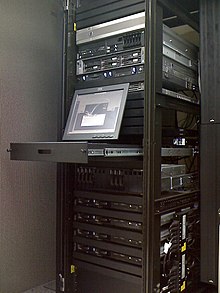
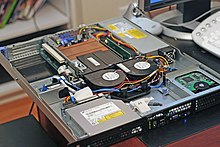
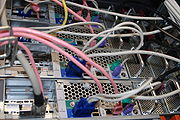
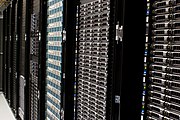
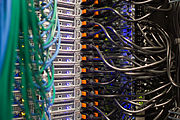
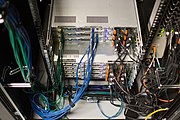
Tidak ada komentar:
Posting Komentar